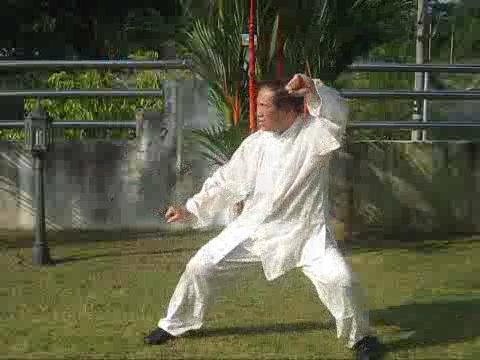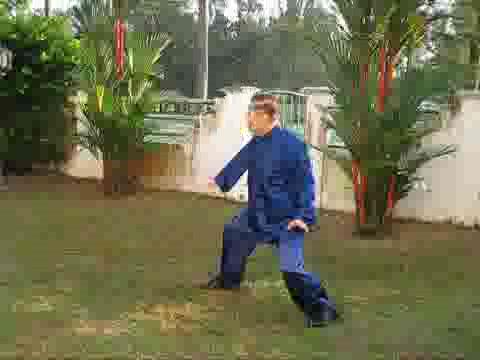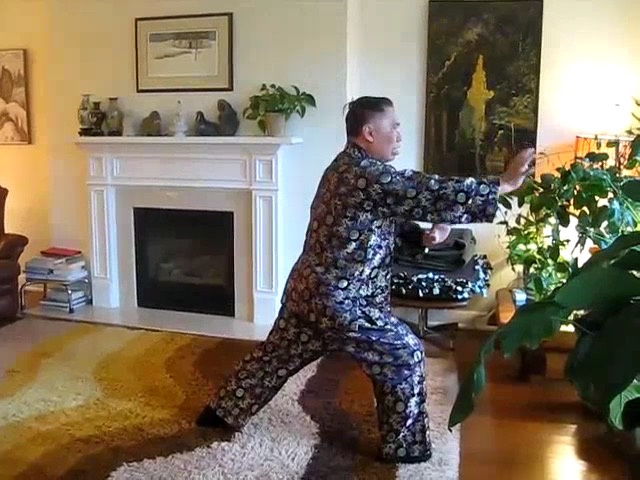WUXING, BAGUA, 10 ESSENTIALS AND 13 TECHNIQUES

Body-movement in Taijiquan
Question
In the treatise of Zhang San Feng it mentions the 5 Elements of Wuxing, the 8 Bagua, the 10 Essentials and the 13 techniques. From my limited experience it seems the full 72-pattern Zhang San Feng set integrates all of the above principles. It is also apparent that to learn all of the above could potentially take a lifetime to master, or even many lifetimes.
With regard to the Tajiquan course this year at the UK Summer Camp do some or all of these principles apply in the short form Abridged San Feng Set, and would Sigung be teaching us any of them in detail on the summer Camp course and what would be the best way to learn and master those above principles? James
Answer
The 5 Elements of Wuxing are usually translated as “metal”, “water”, “wood”, “fire” and “earth”.
Bagua, or 8 trigrams, are (or is, the funny thing about English grammar) “qian”, “kun”,”kan”, “li”, “sun”, “zhen”. “dui” and “gen”, which are symbolized as heaven, earth, water, fire, wind, thunder, marsh and mountain.
The 10 Essential of Taijiquan (called Shaolin Kungfu at the time of Zhang San Feng, the inventor), are as follows:
- Empty the mind of all thoughts
- Do not tense any muscles
- Loosen the waist
- Principle of false-real
- Principle of sinking and pressing
- Using intention and not using strength
- Co-ordination of top and bottom
- Integration of internal and external
- One gentle, graceful flow without any break
- Movement in stillness, stillness in movement
- Peng, or ward off
- Lu, or roll back
- Qi, or press forward
- An, or in contact.
- Cai, or grip
- Lie, or spread
- Zhou, or elbow
- Kao, or anchor
- Jin, or move forward
- Tui, or move backward
- Gu, or step to the left
- Pan, or step to the right
- Ding, or remain at the centre
In Five Elements, when a translator mentions that the Chinese believe the world is made up of five elements, or that the kidneys are “water”, many people may interpret it to mean that the Chinese believe the world is made of five substances, namely metal, water, wood, fire and earth, and that the kidneys are made of water. This is wrong!
What the Chinese say is that there are countless processes in the world, but all these processes can be generalized into five types, symbolized as metal processes, wood processes, water processes, fire processes and earth processes, and that the process of the kidneys is symbolized as water process.
“Wuxing” means “five movements” or “five processes”, but the term “Five Elements” have been established. It is worthy of note that the Chinese character “xing” in “wuxing” is different form the Chinese character “xing” in Xingyiquan, though in Romanized spelling they are the same. “Xing” in “wuxing” means “movements”, and “xing” in Xingyiquan means “form”.

"Black Bear Moves Shoulders" from Wudang Taijiquan Set
While “wuxing” refers to processes, “bagua” refers to form. The Chinese believe that while there may be countless forms, all these countless forms can be classified into 8 main types, symbolized by the eight trigrams.
The father in a family is symbolized as “qian”, represented as “heaven”. This does not mean that the father is heaven. It means that in the concept of bagua, or 8 trigrams, the father is symbolized as “heaven”. “Heaven” or “qian” is symbolized as having majesty and authority. Hence, the father is symbolized as having majesty and authority.
“Bagua” is in Romanized Chinese. In English it is usually written as “Pakua”. Please note that “Bagua” is pronounced as /p’a kua/, and not as /ba gua/. If you think that this is funny, it is because we are familiar with English. Please be reminded that English is very unphonetic, whereas Romanized Chinese is very phonetic.
Please also note that “Bagua” is different from “Baguazhang”, which is usually written in English as “Pakua Chang”, and pronounced in Chinese, English or in any way Baguazhang should be pronounced as /p’a kua chang/.
Personally, I do not find much connection between Bagua and Baguazhang, except a few common factors like Baguazhang Walking uses the Bagua symbol, there are 8 sequences in Baguazhang which correspond to the 8 trigrams in Bagua, and there are 64 main techniques in Baguazhang which mirror the 64 hexagrams in the Book of Change which in turn is derived from Bagua.
Zhang San Feng specifically mentioned that the 10 Essentials were very important in Taijiquan. Those who did not follow the 10 Essentials, did not practice Taijiquan, though they might use Taijiquan external forms. This, indeed, is what is happening now. More than 90% of Taiji practitioners today do not follow the 10 Essentials, though they may perform external Taijiquan forms. Some of them are very important in Taijiquan association and federations.
When I composed the Wudang Taijiquan Set, I used the 72 patterns of Taijiquan mentioned in Wudang classics. These 72 patterns were also mentioned in the Treatise of Zhang San Feng. These 72 patterns manifest the 13 Techniques.
San Feng Wudang Set is an abridged version of our Wudang Taijiquan Set. The San Feng Wudang Set is further shortened to the Abridge San Feng Set. Hence all the three Wudang sets – Wudang Taijiquan Set, San Feng Wudang Set and Abridged San Feng Wudang Set – manifest the 13 techniques.
At first I was puzzled by “ding”, or remaining at the centre, of the 13 Techniques. I understood all the other 12 Techniques. Then, in a flash of inspiration, I discovered what “ding” meant. It referred to body-movement.
The principles of Wuxing, Bagua, 10 Essentials and 13 Techniques can be found not only in the 72-pattern Wudang Taijiquan Set, the San Feng Wudang Set and the Abridged San Feng Set, but in all kungfu sets. In fact the principles can be used to explain anything in the universe.
We may take any Karate kata and use Wuxing to explain what the kata is. We may, for example, say that the thrust punch in Karate is like the process of fire. We may also say that the continuous attack patterns in Karate is like a smooth flow without any break as explain in one of the 10 Essentials.
We may take any everyday activity, like typing at a computer, and employ Wuxing, Bagua, 10 Essentials and 13 Techniques to explain its movement or stillness. When we type a sentence, we may explain this as an integration of the internal and the external, like thinking of the sentence and typing it with the fingers. When we have completed typing, we may say it is stillness in movement, as we are not typing with our fingers but the mind is thinking of the next sentence.
Except for 10 Essentials and 13 Techniques which are particularly concerned with Taijiquan, Wuzing and Bagua are used by people, especially Chinese masters of various arts, to explain everything in the universe.
But this does not mean that certain arts, like Taijiquan, will be particularly useful if we apply Wuxing, Bagua, 10 Essentials and 13 Techniques on them. When we understand the principles of Wuzing, Bagua, 10 Essentials and 13 Techniques, we can greatly enrich our arts and our life.
Whether it will take a lifetime or many lifetimes to learn the principles of Wuxing, Bagua, 10 Essentials and 13 Techniques is relative. It also depends on whether we have the opportunity to learn these principles.
Most people will not have the opportunity. Many may not really understand what Wuxing, Bagua, 10 Essentials and 13 Techniques mean. To them it will take a lifetime or many lifetimes until the opportunity arises.
But those who have read the answer here will know the principles. Those who attend any one of the Wudang courses this year will have practical introduction to application of these principles.
I have not actually decided on what to teach at the UK Summer Camp this year, because it depends much on the level and progress of course participants. Nevertheless, some or even all of these principles will be taught – at an level that participants can understand and to their best benefit.
The best way to learn and master these principles is to study this answer and apply these principles, at a level within your understanding and ability, to the patterns in the Abridged San Feng Wudang Set.

"Green Dragon Tests Claw" from San Feng Wudang Set
The questions and answers are reproduced from the thread Questions to Grandmaster on Wudang Kungfu/Taijiquan & Zhang San Feng in the Shaolin Wahnam Discussion Forum.
LINKS
